A few weeks back we asked some questions to find out how you, our readers, are using your mobile phones. Now we are back with the answers and they have some interesting stories to tell.
Did you ever wonder what kind of phone usage is normal? We seem to have a pretty good idea. Are cell phones still mostly used for making calls or has web browsing already taken over? The answer is right here.
In some places, more people use their phone as a wakeup alarm than they do to make calls. More people use music recognition in North America than in any other place on Earth. You told us what features are used daily and what are only needed once in a while. We also know which are the most wanted but, for various reasons, still not widely used.
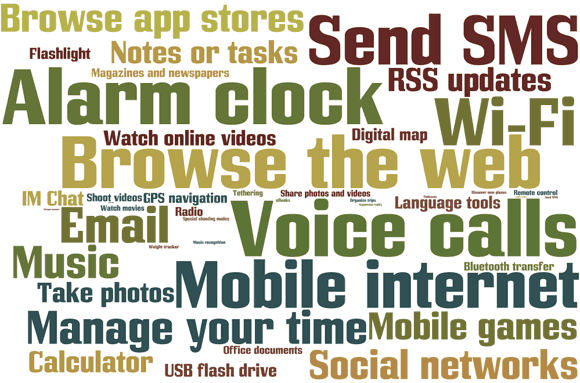
Before we go on though, we’d like to thank you for taking part in our survey so actively. More than 15,000 people responded, 10,000 of which clocked in the first 24 hours alone. As you could imagine, the results should be representative enough given the number of respondents representing various age groups, both genders and different continents.
And while the results can most probably apply to mobile phone enthusiasts all over the world they are hardly accurate as far as the whole world population is concerned. The thing is you, our faithful audience, are not exactly the average phone users. Being so informed and passionate about cell phones (why would you else be here reading all those long reviews) you tend to spend more time with your phone and use most of the features.
Here are some numbers that prove this further: 96% of all respondents browse the web on their mobile phone and more than 88% have a Wi-Fi enabled handset. You won’t be able to bring those numbers to the next class reunion, but you might just learn what your fellow commenters do on their handsets.
One final note before we begin: about 30% of the voters chose not to provide personal information but we still have plenty of feedback to be able to tell how the results vary across the different gender/age/location groups.
Now let’s check out those numbers, shall we? We will be starting with an infographic summing up some of our most exciting findings right after the break।
Most used daily
We start with the most important features, i.e. the ones that are used most frequently by most users. And the winner here… couldn’t have been more obvious… is voice calls.
What came as a slight surprise however is the actual percentage – we expected results more in 95%+ range, so much so that we even considered leaving it out of the poll. Glad we didn’t, because we now see that not everyone use their phone as a phone. And in some user groups, the voice calls are even less popular – less than 65% of the teenagers talk daily on their phones.
In fact, voice calls only rank sixth in popularity in that group and it also loses its top spot among users aged 18 to 24 (though the feature retains a respectable 83% of daily usage there).
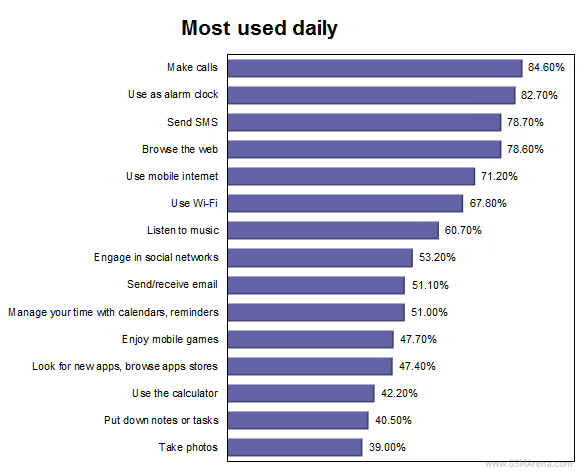
In terms of location, voice calls are most popular in Africa (89.5%) and least popular in Oceania (5th place at 77.6%).
The second most used feature worldwide was a bit of a surprise to us – with 83% it is alarm clock that snatches the silver. The feature even tops the chart for several user groups – women (81.3%), ages 18-24 years (83.5%) and South Americans (86.5%). It loses some ground with the users older than 41, but its popularity is consistently above 60%.
Sending texts might be in decline, but it still retains third position in daily usage. Its overall share is 78.7% and it even gets the number one place in Oceania with 87.7%.
SMS is also enjoying higher than average popularity with Asians (83.8%), where it’s just a tenth of a percent behind alarm clock usage. Surprisingly, only 75.8% of teenagers send SMS daily, which is less than average. Which is not to say that teenagers are no longer responsible for most of the SMS traffic. One possible answer here is that some teens are already switching to instant messaging – our data shows that one third of them are already using this feature daily.
Web browsing only loses a place on the podium by a whisker, which actually tells us how popular handheld browsing is (a mobile version of our site is in the works). 78.6% of the users open their mobile browsers daily. The champions in mobile web browsing category are Oceania (83.3%) and North America (80.9%) with browsing the second most used feature there.
This feature is less often used by women (70%) and users over 50 (63%).
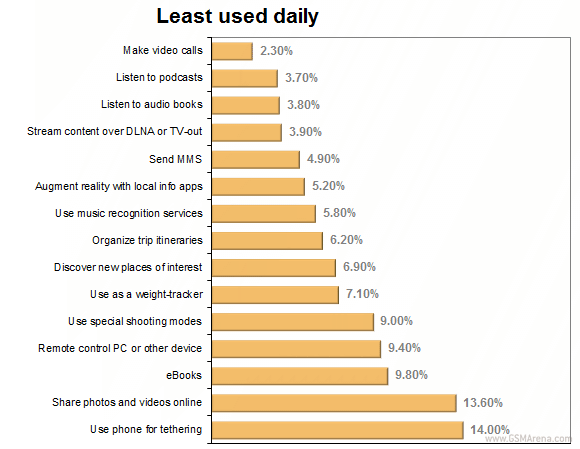
Essential features
The chart we’re about to look at shows the features that are used by the largest number of people. Although not necessarily needed daily, they are the most likely must-haves for users shopping for their next handset.
The obvious leader again is voice calls: 99.5% of you make calls at least ones every few weeks. In Oceania the feature which gave cell phones a reason to exist scores a perfect 100%, while the US gets pretty close with 99.9%.
In terms of overall use, SMS moves up to second place with 99.2%. And it’s another perfect score here from Oceania.
Taking photos is every bit as important as we expected – it grabs the third spot here with 98.5%. It means that less than one in 66 users never use the camera at the back of their cell phone. And half of those have answered that they would use that feature if they could, which suggests that their handsets don’t have a (decent) camera at all.
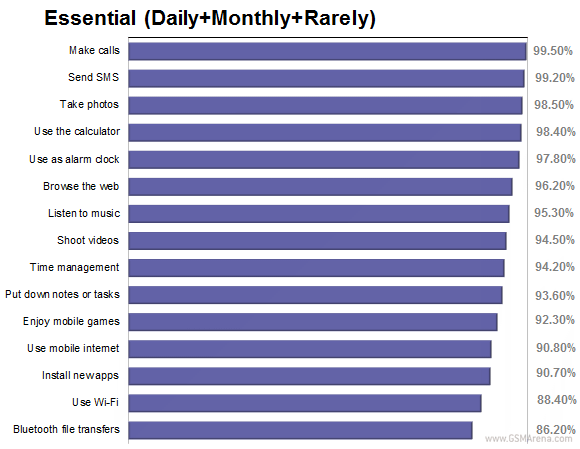
The two features that only just failed to make in to the medals are calculator (98.4%) and alarm clock (97.8%), while web browsing to sixth with the very respectable 96.2%.
At the other end of the spectrum is video calling, which is only used by 26.6% of all users. Only 2.3% of you make video-calls on a daily basis.
Audio books (33.5% total and 3.8% daily) and podcasts (33.8% and 3.7% daily) are not too popular either but they are still head and neck above video-calls. Streaming content over DLNA or TV-out only just avoided relegation with 34.1% users doing it at all and only 3.9% needing it daily.
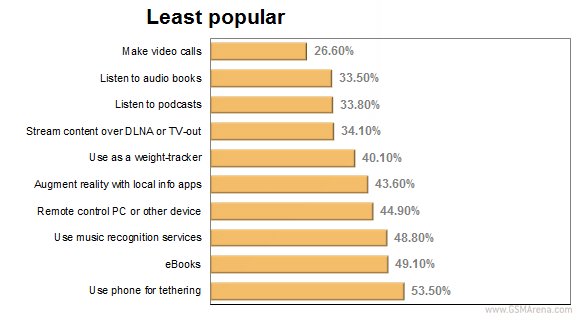
Not needed
We now come to the features, which are the easiest to live without. Those are things people have on their phones but do not use, or lack but don’t want either.
Audio books and podcasts scrape bottom here with more than 60% of mobile users not interested. Books are doing worse with 61.2%, while podcasts are considered useless by “just” 60.7% of you. Somewhat surprisingly these two features are doing notably better in the 50+ age group, where the percentages are brought down to 58.6% and 53.4% respectively.
Weight-tracking completes the anti-award top three but that was to be expected – it’s always been a niche feature. Users of age above 50 are least conscious about their weight (62.9%), while nearly half of teenagers (or 48.2% to be exact) either uses or wants to use some weight-tracking app on their cell phones.
Despite being the least used feature currently (and by some distance) video-calling only ranks fourth here with 50.6%. The difference here comes from the number of people who don’t use it, but would fancy trying it (more on them later). People aged over 32 are mostly indifferent to video-calling, while it is relatively more popular among those aged 25-32 – just 49.1% of them have dismissed it.
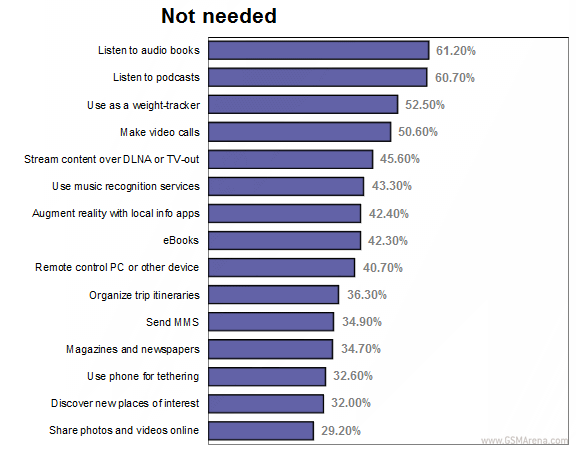
Most missed
Next up is a list of features that people would like to have on their phone. It’s the features most of you have been missing for various reasons –.either the phone doesn’t support them, your carrier bills you out of them or they just haven’t been available yet.
Shock and horror, it’s video-calling in the lead with 22.9%. People who have the feature enabled apparently have no interest in using it, while those who don’t have video-calls are pretty eager to try them. That’s why we feel that despite the high demand this feature might not substantially gain in popularity in the future – it has been tried and rejected once already.
We guess the prospects of the next two features in this list are better (Streaming over TV-out and remote controlling another device). Those have only recently started making their way to mass-market devices and cell phones have been becoming increasingly good at them.
FullHD video streaming has already began to appear on high-end devices, while even mid-range ones can do 720p now. And as mobile data speeds are improving remote-controlling your PC is becoming more and more of an enjoyable experience.
Now that we’ve covered the best and the worst we’d be looking at each feature on its own, trying to explain why it is used the way it is.
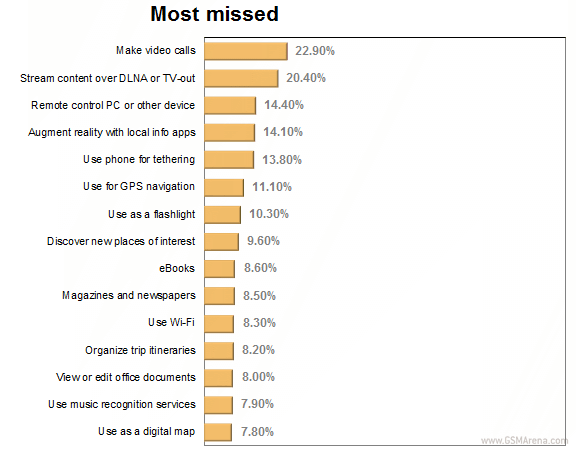
Phone calls
We’ve already covered voice calls extensively so there’s no need to go into further detail. Taking first place in four of the six age groups, four of the six continents and among male users, telephony is still the number one job of a mobile phone, disproving the theory that with the advance of smartphones talking on the phone would become a second fiddle.
However, given that just under 65% of teenagers make calls daily, things are likely to change in the future. One in every eight users under the age of 18 only rarely talks on their phone and one in 70 have given up on the mobile phone’s main feature altogether. It’s still early to talk about data-only plans for smartphones, but there are signs that those might eventually come about.
At the other end of the spectrum, users in Africa mostly talk on their phones, which is easy to explain with the still high costs of mobile data there.
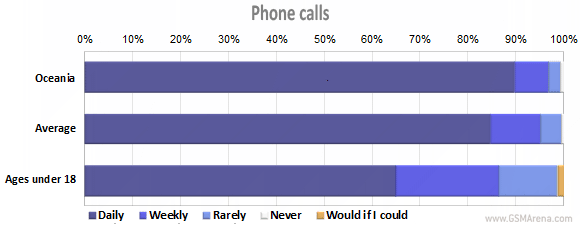
Video calls
From the most popular we move to the least used feature in modern day mobile phones. Just don’t be too quick to doubt Apple’s (and recently Google’s) efforts at promoting the feature.
While every other user takes no interest in video-callingр there’s a huge audience that would gladly try it if given the chance. We can easily see that from marketing point of view, adding video calls to a phone makes a lot of sense. We’d have to wait and see if those 22.6% (and impressive 29.3% in the pre-18 age group) will stick to using video-calls when they can or they will just turn their back on it like the rest of us.
Across the different surveyed groups, there isn’t a big difference in regards to video-calls. Europe is where the feature is used the least. Only 1.3% of Europeans use it on a daily basis, while almost 65% never do and have no interest in using it. Interestingly, women make the most video-calls, but they only reach 3.1% in the daily column and another 2.7% on a weekly basis.
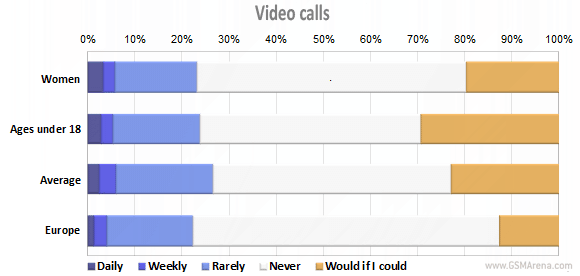
Short message service (SMS)
We take another trip across the popularity table and we are back near the top of the charts with SMS. The third most popular application of cell phones globally is doing really well among women – 81% of all female users text daily, while another 17.3% also confess doing it, only less regularly. Ok, that last part may come out wrong if you strip it of context.
Texting is most popular with users in Oceania (all of the surveyed use the feature and a good 87.7% of them do so daily). In fact, it takes the number one spot there beating voice calls by over 10% in the daily usage column. Asians and users aged 18-24 are the other two groups that text more than average.
The only ones that are not as keen on SMS are, expectedly, users of over 50 years of age.
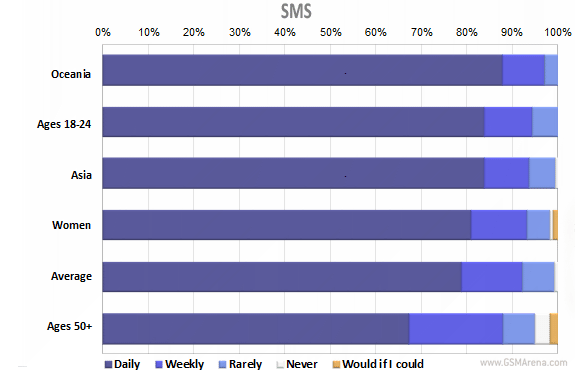
Multimedia message service (MMS)
This next feature is not so much of a has-been as a never-were. Multimedia messages never reached the popularity that carriers probably hoped for and are now among the least used things on a mobile phone.
Despite being so widely available, MMS is used by just 4.9% of all people daily and we have to admit that even that number sounds too high to us.
It’s mostly North Americans that send these messages – one in seven users does so every day and more than one in five each week. Female users are also using MMS fairly regularly, exceeding the average usage more than twice.
MMS is not going to be extinct any time soon though – at least half of respondents admit they use them occasionally.
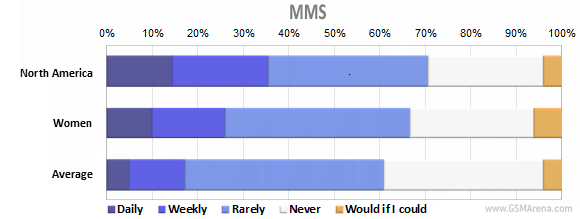
After a feature in decline, we move to one that’s on a sharp rise. Emailing is still far from the top spots, but it’s already being used daily by more than half of all people. Another 32.8% use it on occasion, which gives an impressive total of 83.9%.
Surprisingly, teenagers send or receive email the least (just 30% daily users and 72.9% of total users). However with those of you over 24 years the daily percentage rises above 60. Understandable, given the importance of email in most jobs nowadays.
We can’t help but be impressed by the number of email users in Oceania and North America .
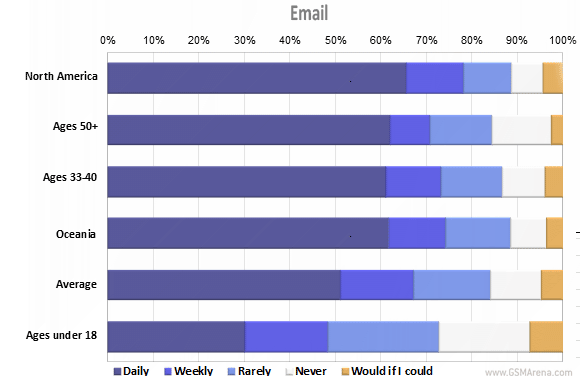
Instant messaging
Instant messaging is another area where mobile phones have been vastly improving recently. Being probably the handiest messaging option, IM’s only problem at this stage is it’s pretty data-traffic-intensive.
Still, one in three users globally and about half of those aged 18-24 use an IM service daily. The feature is still to gain speed with people older than 41, who probably don’t have the time or the habit.
South Americans, Asians and Africans are also very keen on Instant messaging, while Oceanians seem least interested.
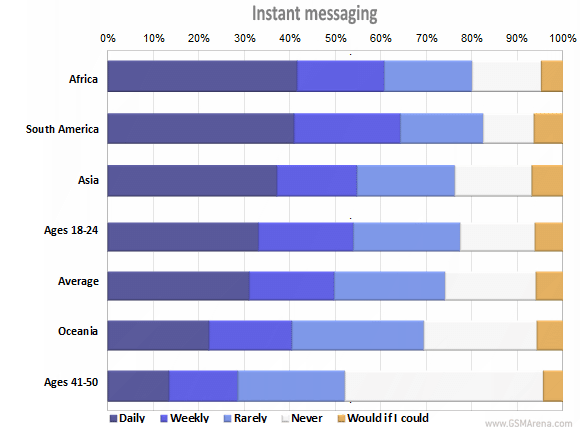
Social networking
Social networks are all the rage these days and given how important it is to always be online, it’s only logical that more and more people are using their cell phones to engage in social network activities.
By current count, 53.2% of users update their status, upload photos, read updates and whatnot on their cell phone every day, while another 26.6% do it occasionally. With just 3.8% of you selecting the “Would if I could” option, it’s more than clear that social networking has already been made available to about everyone who wants to try it.
Naturally, it’s the younger users (up to 24 years) who are the most active, with the number using the feature daily nearing 60%. Expectedly, with users over 50, the percentage drops below 25.
In geography terms, it’s Oceania in the lead, while conservative Europeans are obviously not as enthusiastic about handheld social networking.
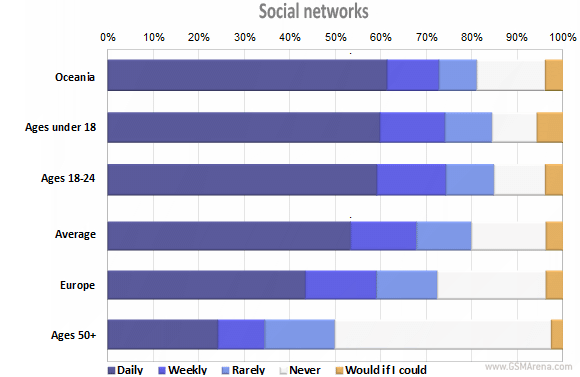
Taking photos
For a while there, the megapixel war and the cameraphone evolution seemed to have stopped so we were wondering if people had actually given up on the idea of having their cell phone replace their digicam. Then came the N8, which became insanely popular and we knew it was just a temporary loss of form rather than a decreasing trend.
The poll results come to confirm this: 39% of daily usage doesn’t sound like much, but that is easily explained with the fact that there’re just not many things you need to shoot everyday.
However the total user base of 98.6% for this feature leaves no doubt that our readers like to take photos with their cell phones. Even in the group that takes the least photos - women - only 2.7% never use the feature and that is including the 2% that would like to give cameraphones a try.
As far as frequency is concerned – photography seems to be an age thing – teenagers are most likely to take photos on a daily basis, while 50+ users only use the camera on their handsets once a week.
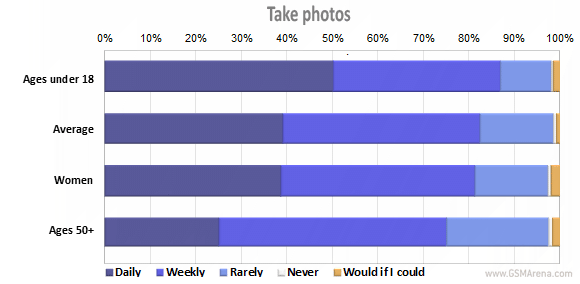
Using special shooting modes (panorama, HDR etc.)
We were curious to know if many of you were using the so-called special shooting modes that are nowadays considered essential in every self-respecting cameraphone. It looks they have a quarter of the daily popularity and about 75% of the total popularity of taking photos in general. By all accounts, they emerge as must-have’s – mobile photography wouldn’t be the same without them for three quarters of the users out there.
Interestingly enough, women use those feature more than men, despite shooting less. Teenagers are, of course, the most active in their usage, but that’s just because they also take the most photos. Extra camera features are also way more popular than average for users in Asia.
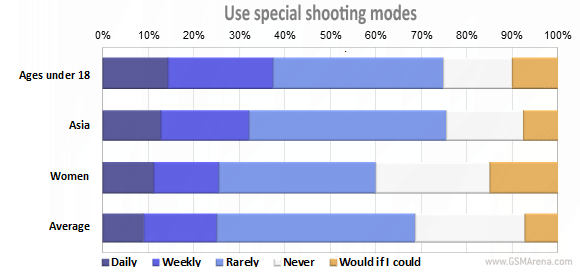
Shooting video
Understandably, video capture isn’t as popular as still photography for mobile phone users. This is mostly explained by the fact that by the time 8 megapixel cameras were available on mobile phones, the camcorder capabilities still hovered around VGA or D1. It was always easier to find a decent still camera while video recording was, until not too long ago, often left out of the spotlight.
But no more – the 720p and 1080p barriers were broken in quick succession, while continuous autofocus and lossless digital video zoom started making their way into the smartphone world. At this point top-end smartphones are some decent image stabilization away from matching digicams in video recording.
And when that happens (or even before that) we believe the 13.4% of daily users will increase rapidly. Still we don’t think it will ever match the still shooting popularity as still pictures are often used for other purposes – capturing labels instead of writing notes, scanning barcodes etc.
And just like still photos, videography is an age thing – the younger are the most likely to shoot a video clip each day. And just in the same way, women are far less likely to do it than men.
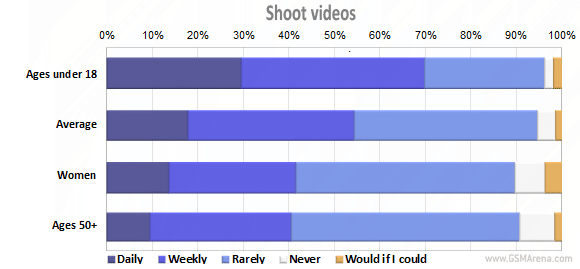
Sharing photos and videos
From creating content to sharing content – the step is getting shorter and shorter as cell phones in general, and smartphones in particular, evolve. No wonder then that 13.6% of all people share a photo or video at least once a day, while one in five uploads some images or footage each week.
One in three users worldwide uses photo/video sharing on their mobile very rarely, but the tendency is there for everyone to see.
Given the little interest they have in social networks and instant messaging, it’s hardly a surprise that people aged 50+ are least likely to share the content of their cell phone galleries. It’s definitely an age thing.
Looking at the geography, we once again see South America in the lead with Europe lagging behind.
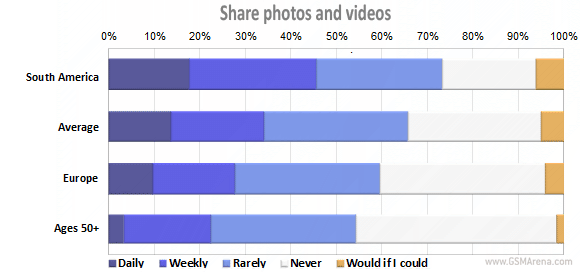
Listening to music
Did you know that iPods were the only part of Apple’s otherwise booming portfolio that is suffering a drop in sales just about every quarter? Well, here’s the explanation – 60.7% of all people listen to music on their mobile phones every day, while another 34.6% do so every now and then.
And it’s yet another feature that highly depends on age. In fact listening to music is the top daily activity in the teenager age group, while it only ranks 12th among the 50+ users.
Across continents, it’s Europeans that listen to music the least, while Asians score more than 10% above the average on daily usage.
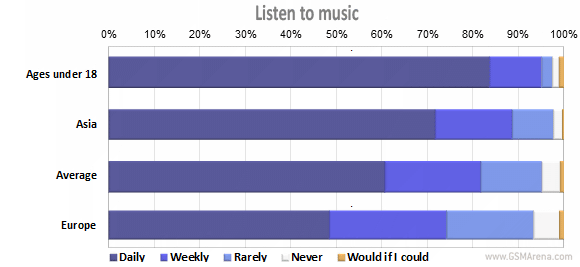
Listen to radio
We were wondering if an FM radio receiver is still an essential feature. Well it turns out that it is pretty important – one in five users turn on their radio app daily, while another 56.6% use it from time to time.
Also 5.2% of the respondents would love to use the feature if they could – those are mostly iPhone users we assume as the percentage of users that selected the “Would if I Could” option is highest in North America (just kidding!). South Americans are the most active here as they have the least percentage of people who answered Never, while users in Oceania are the least interested in the feature.
Apparently, online radios are not a good enough alternative just yet. Maybe people wouldn’t waste megabytes from their pricey data plans that could be better used elsewhere. And a constant data connection is way more taxing on the battery than god old FM radio tuner.
Unlike listening to music, radio isn’t really dependent on age – users in the 18-24 age category use it the most, but the difference across the age groups isn’t that big.
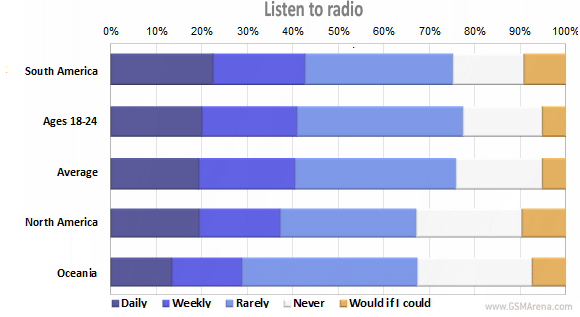
Audio books
There’s not much to tell you here really. Audio books struggle to make an impact – just 3.8% of you use them daily, the total users are under 35% and the rest don’t seem too keen on starting.
Audio books have somewhat higher than average popularity among teenagers (we assume they prefer them to normal books for their mandatory school reads) and users in Africa. The latter are mostly women – 5.5 on a daily basis.
Oceania users and those aged over 50+ do not seem to have any interest in using their phones as audio book players.
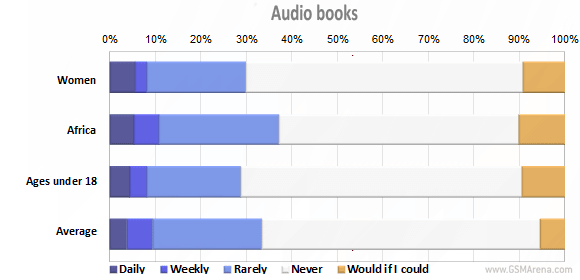
Podcasts
Podcasts on your cell phone? No thanks, say most of you – 60.7% to be exact. Their overall popularity is about the same as that of Audio books, but their strongest demographic is different – North Americans, aged 32-50. Africans and those aged 18-24 seem particularly uninterested in podcasts, though you will notice that the differences are way subtler here.
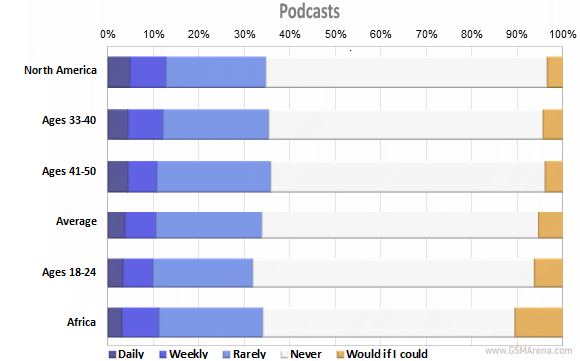
Using music recognition services
Music recognition services were always meant to be a niche complimentary feature and we are actually surprised that 5.8% of you use one daily. The fact that 43% of our readers use music recognition occasionally is not surprising, but it’s weird enough there’s a new song that someone would want to check out every day.
It’s teenagers who use such services the most. Ages 41-50 are using this feature the least.
Geographically speaking, North Americans love those services, while their south neighbors seem uninterested. The rest are pretty close to the average.
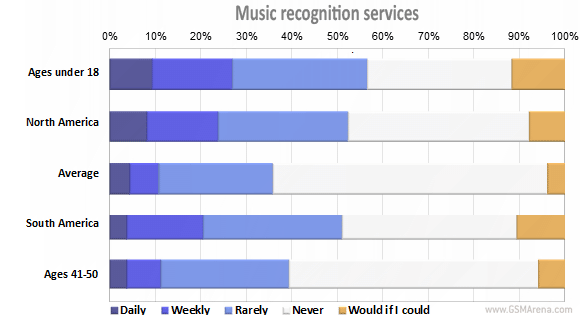
Watching movies
The screens are getting bigger, blacks getting deeper, codec support is better and the processing power is catching up with netbooks – video watching is quickly becoming a viable option for cell phone users.
14.8% are already checking out at least one video per day on their handsets, 22.9% only find the time once a week, while more than half of the rest still watch movies, even if rarely. And there are some that are still waiting for cell phones to improve that extra bit to join the fun. Not bad, considering that five years ago watching a movie on your cell phone was something very few people would so much as consider.
Like listening to music, video watching is a territory reserved for the youngsters. Just one in 20 people over 50+ turns on their phone to watch a movie every day, in the under 18 age group it’s one in five.
But of all defined groups in our survey, it’s Asian users that watch movies the most. Europeans are at the other end of the spectrum, but strangely it’s women and the aforementioned (50+ group) where movie watching on a cell phone popularity hits rock bottom.
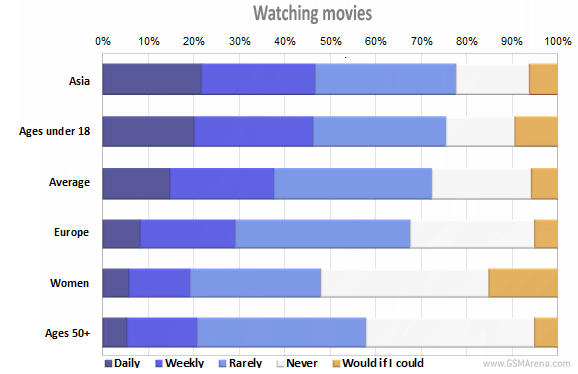
Watch online videos
If movie watching was a rapid evolution then this is nothing short of revolution. Driven by music videos and short funny clips, online videos popularity is almost double that of regular movies.
Once again, women are far less impressed by mobile videos than men, while age distribution is distinctly skewed towards the young.
Users living in North America tend to watch online video from their handsets the most, while African users have selected the Would if I Could option more than those in any other continent.
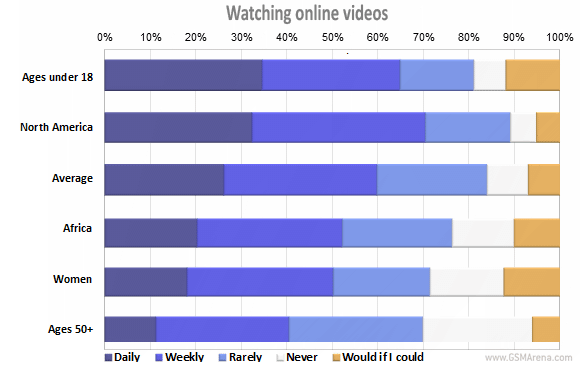
Stream content over DLNA or TV-out
And while watching videos on a phone is a popular pastime, streaming them over DLNA or a regular TV-out is still not that widespread. You see, TVs are only now getting up to speed, cables are not always at hand and content stored on phones is rarely good for streaming.
Still this one scores big in the last column, which means that it probably has a bright future ahead of it. African users are most eager to try it out, but the demand is consistently high across all continents.
Right now, teenagers tend to give the relatively new technologies a better chance than the other age groups (DLNA more than TV-out, of course). Across the world usage of the feature is pretty evenly matched - North Americans are slightly more enthusiastic than average, while Europeans are once again slow to adapt the new technology.
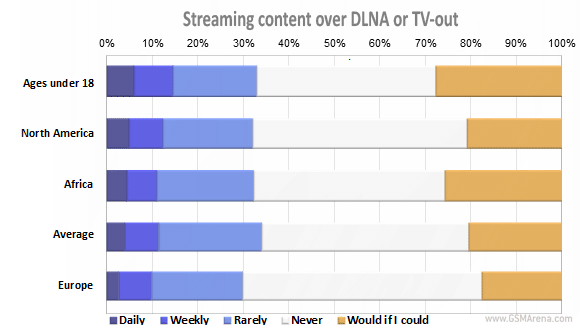
Mobile Gaming
Mobile gaming is currently enjoying so much success that app stores are judged by the number of high-quality games they offers. Popularity with youngster exceeds 60% as far as daily gaming is concerned and while interest in mobile games gradually drops as age increases (and free time shrinks) the overall result is 47.7%. And if you include those that play games on occasion the result is over 90%.
Asian users game the most on their cell phones, while Europeans are not much into that. Women tend to play mobile games less than men, though the difference is quite subtle.
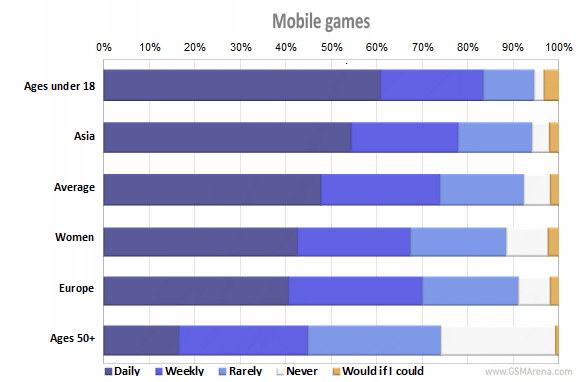
Web browsing
The proportion of users who browse the web on their phones was quite a surprise to us – 78.6% daily and over 96% total. In fact, just one in 80 respondents have never browsed the web on their handsets.
Women tend to lag a bit behind here – their daily usage is more than 10% lower than that of men. The same goes true for people over 50, while the numbers for other age groups are consistently high.
Oceanina holds the lead in mobile web browsing with over 83% of the users visiting at least one web site on their phone each and every day. South Americans rank lowest here at just 73.4%.
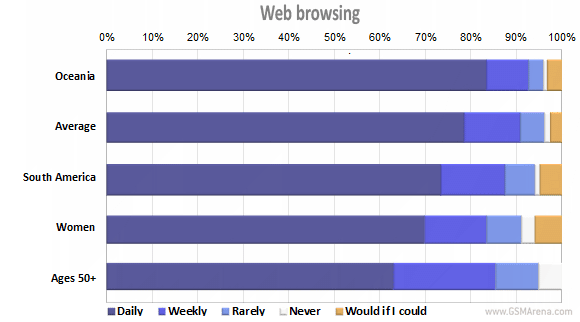
Getting RSS updates
Surprisingly, RSS feeds are best appreciated by those aged over 50, with those aged 25-32 coming a distant second. Teenagers on the other hand use that feature half as much.
The RSS feeds are most popular among North Americans, while South Americans tend to use them the least.
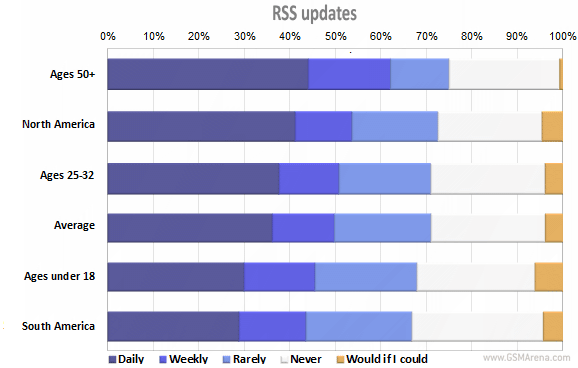
Installing new apps
Apps are the bread and butter of a smartphone ecosystem – you can’t be too surprised that almost 45% of the people check out their app stores daily, while the total visitors who browse app stores are twice that number.
Women and users over 50 do so less regularly, while teenagers hang there the most.
Across regions things go like this: Europeans look for new apps less than all other continents, while Asians are the most active in the app stores. Differences here are pretty minor though.
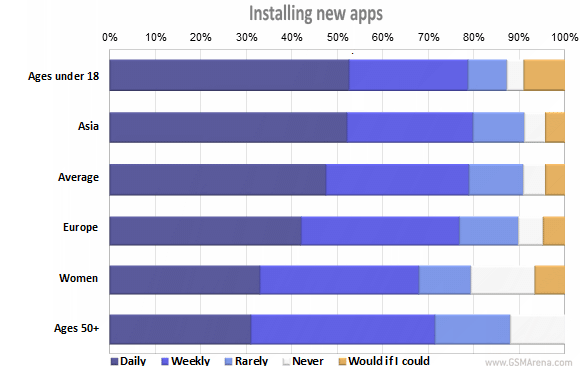
Using as a digital map
Digital maps are readily accessible, free and increasingly accurate – no wonder their popularity spiked as data transfer charges settled and we should be seeing more of them in the future.
Women are using this feature much less than men (we guess they’d rather stop and ask for directions). In terms of age, popularity peaks in the 25-32 year group with interest notably dropping among both very young users (who don’t drive yet) and users aged over 50 (who prefer either regular maps or dedicated SatNav units).
North Americans need their cell phones to double as a digital map the most, while surprisingly it’s Europeans that use this feature the least. Even Africa, where the map coverage is questionable in places, is ahead of the old continent.
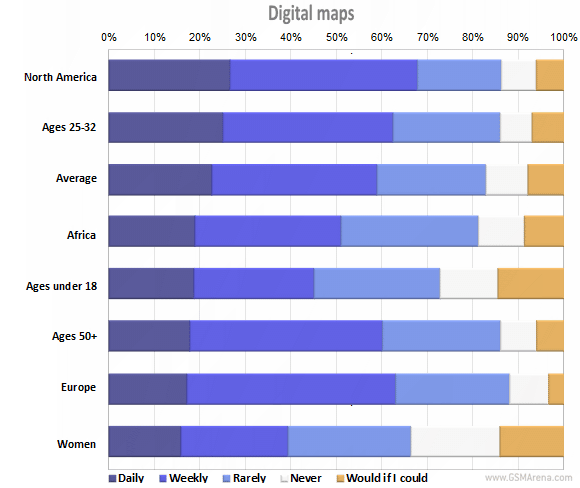
GPS navigation
Now, navigation on the other hand is still not as readily available everywhere. Most platforms don’t offer free navigation just yet and those that do hardly cover the whole world. Nokia certainly helped here by making Ovi Maps navigation free and we’ll probably see another spike in day to day usage when Google Maps navigation becomes available in more regions.
But the factors just listed aside, usage among different groups varies in the exact same way as digital maps. You’ve got the 25-32 year-old’s and North Americans using it the most, while women, youngsters and Europeans do it the least. The only difference is that popularity here doesn’t drop as rapidly with people over 32 years of age.
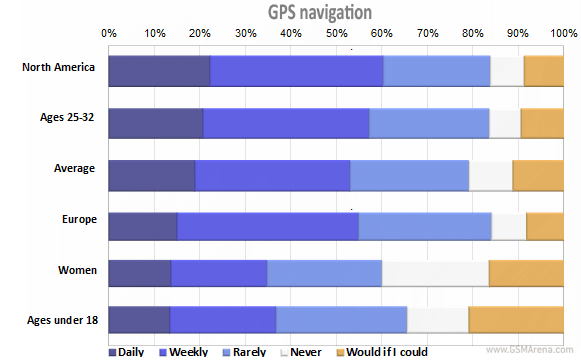
Trip planning
Not many people take trips daily so it’s no surprise that Trip planning on your mobile phone scores pretty low on daily usage. Still good numbers in the weekly and occasional use categories suggest that cell phones are an important enough tool for organizing your trips.
There’s no difference in usage between genders here, but patterns do vary with age. People in their late twenties and early thirties are naturally the most frequent users. Teenagers on the other hand hardly have that many trips to organize.
People in Oceania use their phones for managing their trips the most, while South Americans hardly bother.
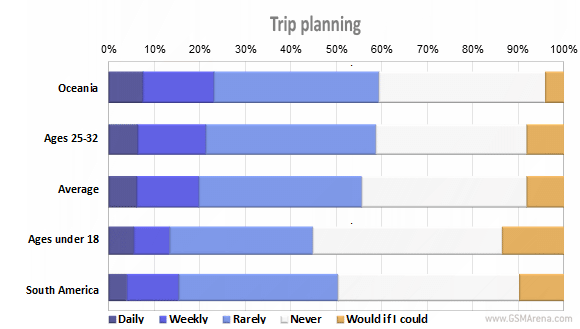
Discover new places of interest
Discovering new places of interest even does slightly better than the trip planning on overall score. Again we thought it’s not something you normally do every day, but there are people who would disagree.
There doesn’t seem to be an easy to define relation between usage of that phone application and age, as it’s more popular with users aged 18-24 and least with those in their forties.
Asians find the most places using their cell phones, while Africans are still hesitant to trust their handsets for that. Perhaps the expensive data charges in Africa have their role.
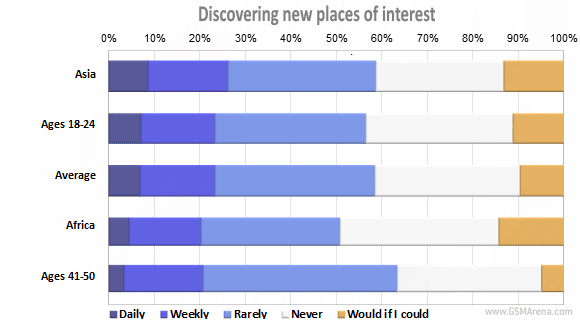
Augment reality with local info apps
According to our survey augmented reality apps are among the least used on a daily basis. Their overall user base is 43.3% of all cell phone users, but only 5.2% of them are using them each day.
Obviously developers and manufacturers are still struggling to come up with concepts that are particularly useful for the whole audience. The good news is there’s a good amount of new users to be converted with the “Would if I could” answer selected by good 14.1% of the surveyed.
Augmented reality apps are the most popular with teenagers, and as age increases they become less and less appealing.
Currently, North America is the largest market of augmented reality apps, while Europeans are the least interested in them.
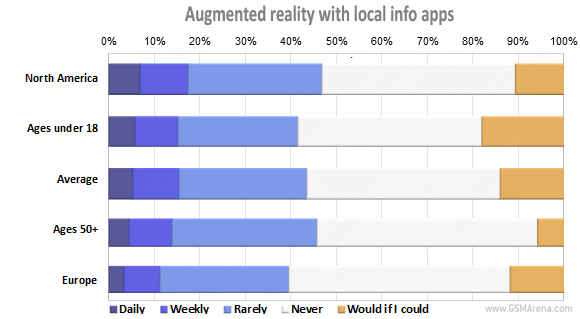
Time management with calendars, reminders etc
The organizer is one of the most frequently accessed parts of each cell phone UI. One in every two users does some time-management on their handsets daily, while one in four uses the organizer at least once a week.
Those who do not use their cell phone’s PIM features are mostly teenagers. The popularity of that particular feature increases with age to reach its peak in the 41-50 year olds.
Cell phone PIM popularity doesn’t vary too much across continents, the least frequent users (Europe) only a few percent behind the most active ones (Oceania).
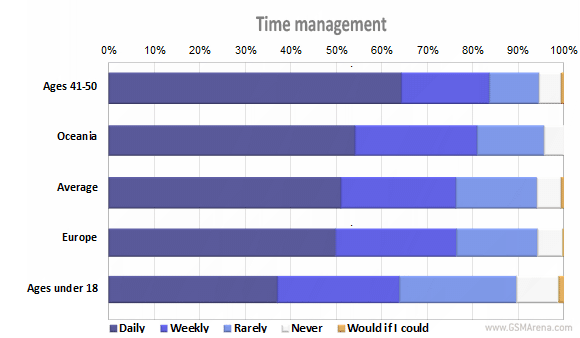
Alarm clock
Not too long ago we said that cell phones must have spelt doom for alarm clocks, but even we didn’t expect this to be one of the most used features of modern day handsets. That’s a total of 97.8% of all phone users, with 82.7% using it daily.
And we can certainly see the reasons for this – the phone is always with you, it’s loud enough to wake you up and it even might have a few cool features like sleep cycle recording or a gentle wake-up.
Those youngest (under 18) and oldest (over 50) use the alarm clock feature the least, while the peak of popularity is in the 25-32 age group. As with other so wildly popular features, usage differences across continents are negligible.
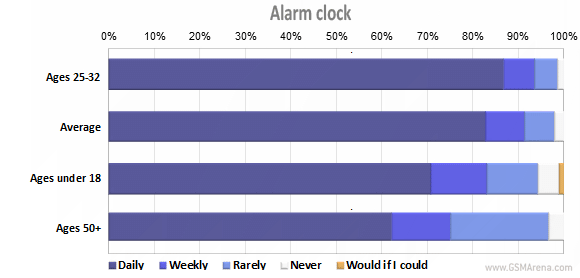
Language tools
The popularity of language tools came as a huge surprise to us. We knew there were some people using their phones to translate short texts or look up an occasional definition but we certainly didn’t expect that nearly 90% of you use their cell phones for that.
It’s worth noting that this is another distinctly age-specific behavior. Those under 18 use language tools the most (helping with school assignments we suppose) and their popularity gradually drops as we move towards older users.
Interestingly, use of the feature on a daily basis in Asia is more than double that in Europe. But we’re seeing this trend with some other features as well.
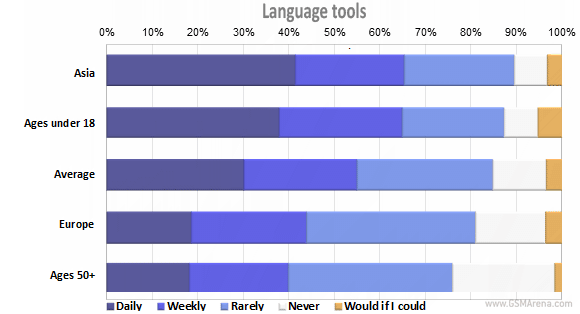
Calculator
The pocket calculator is perhaps another gadget facing extinction at the hands of the cell phone. This is an extremely handy feature to have on a phone and many people of all continents and age groups are using it.
Unsurprisingly, it’s the under-18 age group that use their handset’s calculators the most. What we can’t quite figure out is why Asians are using this feature so much more than Europeans.
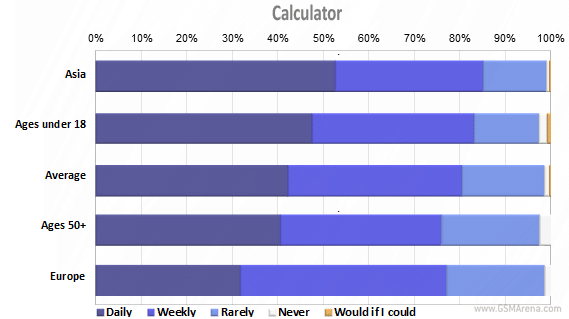
Taking notes
Another thing that cell phones are particularly good at these days – taking short notes and keeping reminders always at hand. It’s no wonder that over 93% of all users have some kind of a Notes app and put it to good use.
This is probably the most balanced usage pattern across different age groups and gender. Just a few percent separate the teenagers from the middle-aged people and those over fifty.
The only notable differences are related to location – just 33.6% of the Europeans take notes on their handset daily, while about 47% of the Asians do.
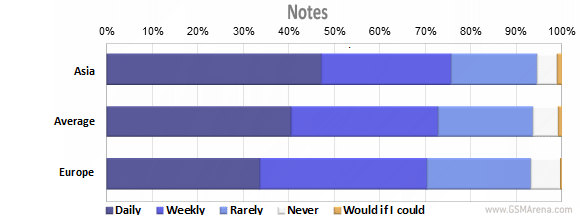
USB flash drive
Plugging in your cell phone in your computer and using it as a fully functional flash drive is what 80% of you do at least occasionally and 27.2% perform daily.
Interestingly, women don’t use this feature as much – under 74% of total users, though another 10% of the female users would try this feature if it was available to them.
Teenagers are the biggest fans of the mass storage mode, whereas users over 50 are the least interested.
Another trend we noticed here is that South Americans like to transfer files on their handsets way more than Europeans.
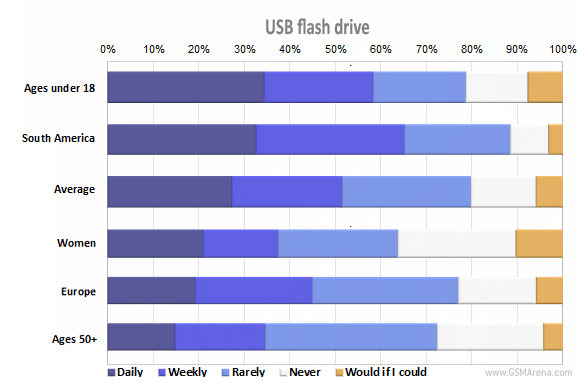
Flashlight
Using a cell phone as a flashlight is already pretty widespread but over 10% of the users still wait for their chance to try it. LED flash units might not be too useful as a photo tools, but they seem to serve the purpose of a flashlight hust fine.
Flashlight usage is another thing that is most popular with teenagers and it gets less and less popular as you move towards older age groups.
Across continents, we noticed that Asians are more likely than Europeans to turn on their torch.
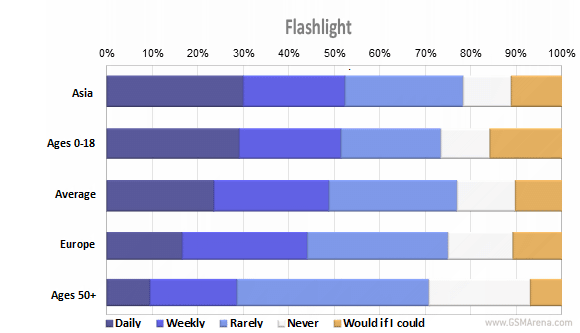
Weight-tracking
Weight tracking may as well be one of the least popular features of mobile phones, but with 40% of all cell phone owners using to it at least occasionally it’s not as uncommon as presumed. To be honest, we didn’t think so many people were so conscious about their weight.
Women use this feature the most but weight-watching is quite popular in Asia too.
There’s also a notable trend with older people (over 41 years of age), who don’t seem to go anywhere near the average usage.
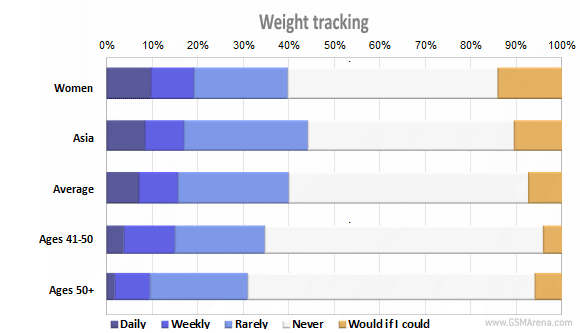
Viewing and editing office documents
Cell phones are becoming increasingly good at handling office documents and we have the numbers to prove it – 16.6% of all people browser or edit such files on their handsets every day. Another 58% only need the feature once a week or more rarely but will miss the feature if it was to be removed from their handsets. There’s also an extra 8% that would be interested in getting document handling enabled on their mobile phones.
To confirm what we all thought, women and teens tend to use document viewing/editing on their phones the least. Interestingly though, both groups have the highest percentage of “Would if I could” answers – maybe they just don’t find cell phones comfortable enough for the task.
Users above 50 are only slightly more active than teenagers here and theirs is the highest number of people who are completely uninterested in the feature. People aged 41-50 on the other hand are the biggest fans of mobile office apps.
We should also note that Europeans view or edit documents on a daily basis almost half as much as Asians.
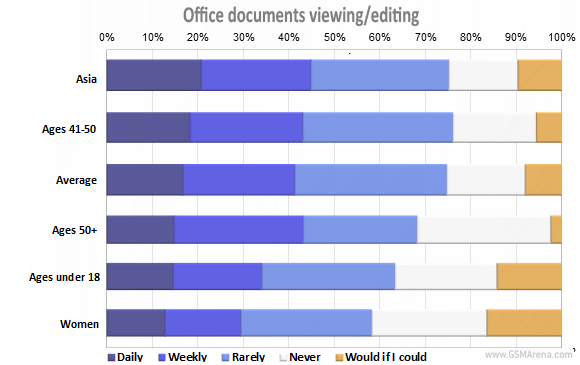
eBooks
We’ve got to be honest here – even high-end smartphones don’t make too great eBook readers. We are even a bit skeptical about tablets but that’s not an argument to go into now.
What matters here is that eBooks are only used by 9.8% of all users on a daily basis. Usage peeks with ages 18-24, while the other age groups are hovering around the average.
And we are seeing yet another feature that’s twice more popular in Asia than in Europe.
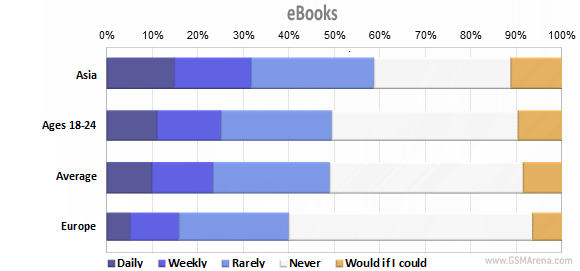
Magazines and newspapers
Magazines and newspapers tend to be better suited to cell phones than eBooks – staring into tiny LCD screens isn’t as tiring for shorter reads. That would explain the extra 7% of daily users, mostly at the expense of the “Never” column.
They also have a different usage pattern in terms of age – people over 50 do double the newspaper and magazine reading the teenagers do.
Women also seem less interested than men, the feature is most popular in Asia.
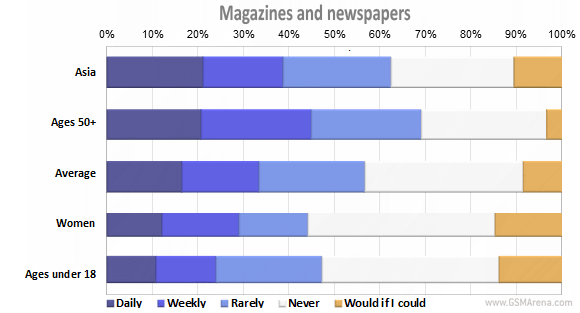
Mobile internet usage
As mentioned earlier, this is one of the most telling signs that more geeks took the poll than Average Joes. Over 90% of the respondents are avid mobile internet users with over 71% using it daily. Mobile internet has been steadily on the rise, but our dear readers are a few steps ahead of the natural evolutionary curve.
Teenagers are the only ones to score well below average here and we suspect it’s the related cost that holds them back.
Oceania has embraced carrier-provided internet whole-heartedly – over 82% of them use it every day.
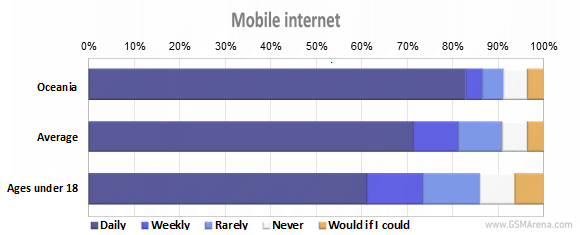
Tethering
Providing internet connection to another device is high on the priority list of most manufacturers these days. The only thing is smartphones are evolving so quickly it makes little sense to use them as a simple modem – most of the web browsing tasks could be handled (and, judging by this poll, already are) on the handset itself.
Still, tethering is relatively popular even if most of the people tend to only use it on occasion.
All groups up to 32 years of age use tethering about the same while after that there’s a notable decline (41-50 year olds do tethering the least).
Despite having no specific carrier-enforced restrictions Europeans are the single group with the least interest in tethering, while users in Oceania are all for it.
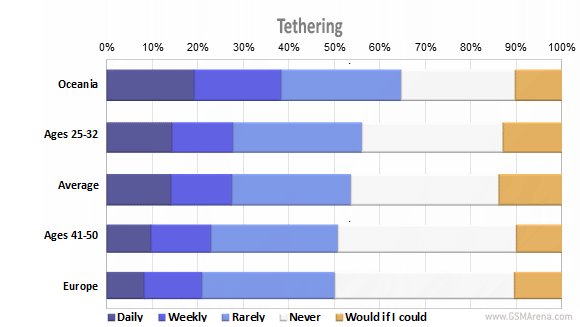
Bluetooth file transfers
Wi-Fi Direct is already there but the problem is no handsets can actually use it yet (despite the certificates already issued). And until that becomes possible transferring files over Bluetooth will remain quite popular, no matter how slow.
A quarter of the users have at least one Bluetooth file transfer A day, while two in three make such transfers once a week or rarer.
Teenagers are most keen on Bluetooth file sharing, while women and those aged over 50 are least interested.
You might be shocked to hear that the daily use of Bluetooth file transfers in Africa and Asia is almost three times the number for Europe. Well, we are not. Europeans seem to be rather stiff about almost all mobile phone features in our survey.
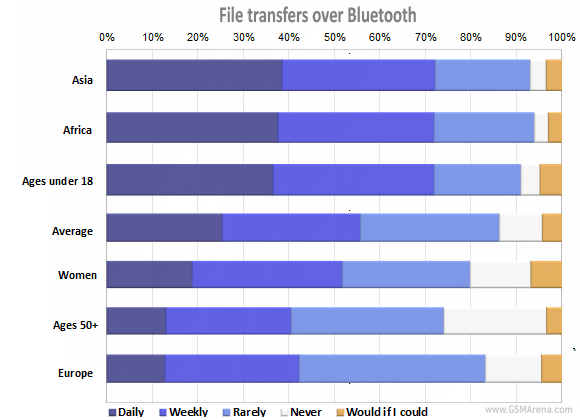
Remote controlling another device
Using a cell phone to remotely control another device is what many of you would like to do if given the chance. 14.4% of all people that completed the survey went for the “Would if I could option”.
On the other hand a huge 40.7% have no interest in using such a feature on their handsets. In regular day-to-day usage, the feature is rather unpopular with only just 9.4% needing it daily.
Being able to always access their PC from their cell phones is way more important to teenagers than people in older age groups.
For a change, there’s little difference in usage patterns across continents. Asia is again ahead of the curve.
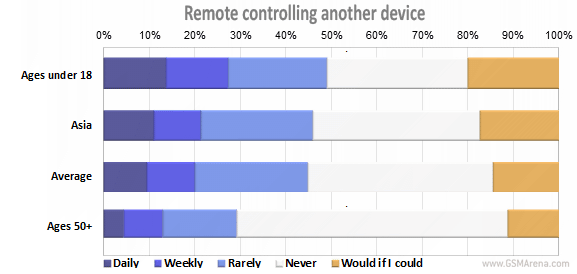
Wi-Fi
We complete our survey with the use of Wi-Fi. Interestingly, it loses to mobile internet usage but the reason is there for everyone to see – it’s still not available to all the people that might possibly need it.
Women tend to use Wi-Fi less than men, while age group distribution is quite even. Only the 50+ users tend to be slightly off the pace.
The picture is similar across continents, with Africa and Oceania the only two to stand out from the average.
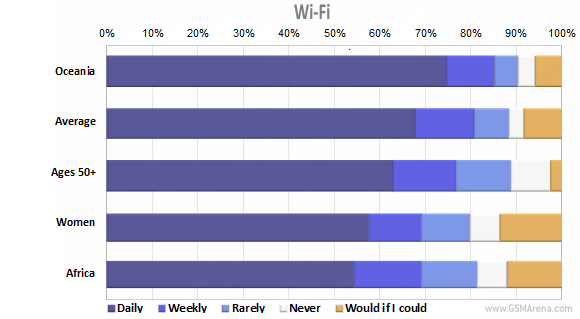
Final words
So that’s that then – we gave you all the answers you gave us, all chewed and easy to swallow. We hope we’ve been of some help. We’ve been asking ourselves many of the questions answered here and we hope those have fascinated you too.
There are some interesting trends showing up – traditional phone features (making calls, SMS and MMS) are starting to lose popularity, but they are still the reason why people buy cell phones. Yet as internet-browsing, IM and email gather continue to gather momentum, we might see those slip further down the ranks.
Probably the most important conclusion is that being always online seems to already be a must for the most of you – something we couldn’t even dream of several years ago. The progress in this area has been remarkable.
Anyway, it seems we have no choice now but do a follow up to this article in a few years’ time. For all we know though, it maybe a future we cannot even start to imagine.
No comments:
Post a Comment